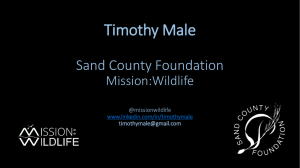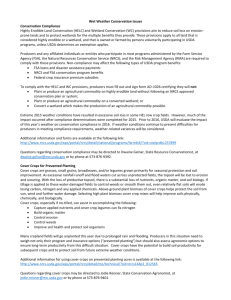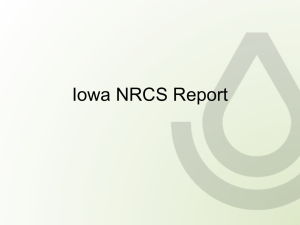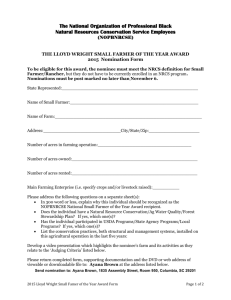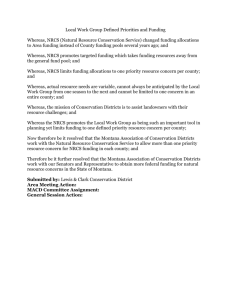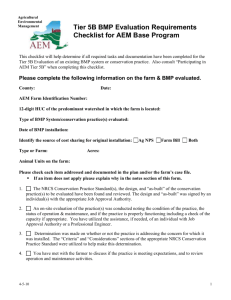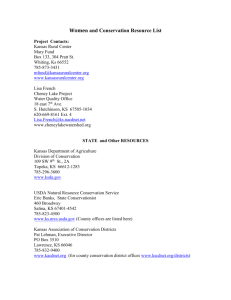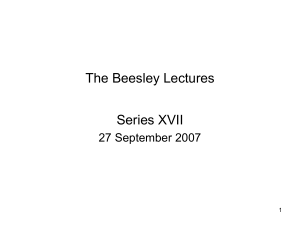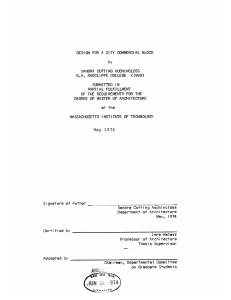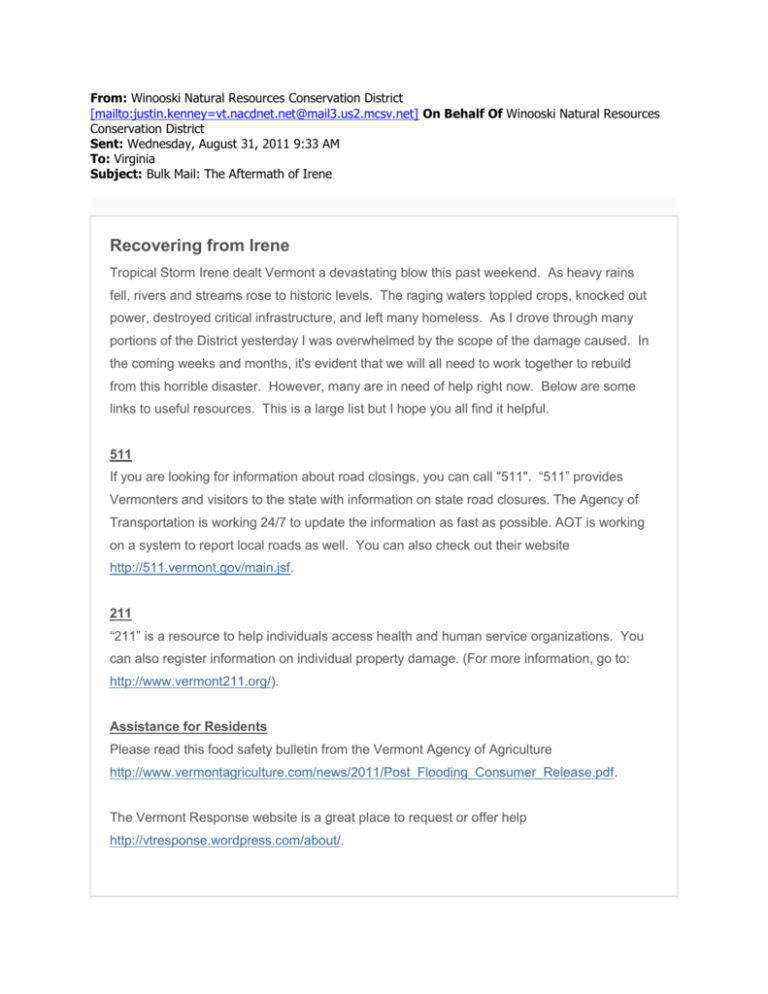
From: Winooski Natural Resources Conservation District
[mailto:justin.kenney=vt.nacdnet.net@mail3.us2.mcsv.net] On Behalf Of Winooski Natural Resources
Conservation District
Sent: Wednesday, August 31, 2011 9:33 AM
To: Virginia
Subject: Bulk Mail: The Aftermath of Irene
Recovering from Irene
Tropical Storm Irene dealt Vermont a devastating blow this past weekend. As heavy rains
fell, rivers and streams rose to historic levels. The raging waters toppled crops, knocked out
power, destroyed critical infrastructure, and left many homeless. As I drove through many
portions of the District yesterday I was overwhelmed by the scope of the damage caused. In
the coming weeks and months, it's evident that we will all need to work together to rebuild
from this horrible disaster. However, many are in need of help right now. Below are some
links to useful resources. This is a large list but I hope you all find it helpful.
511
If you are looking for information about road closings, you can call "511". “511” provides
Vermonters and visitors to the state with information on state road closures. The Agency of
Transportation is working 24/7 to update the information as fast as possible. AOT is working
on a system to report local roads as well. You can also check out their website
http://511.vermont.gov/main.jsf.
211
“211” is a resource to help individuals access health and human service organizations. You
can also register information on individual property damage. (For more information, go to:
http://www.vermont211.org/).
Assistance for Residents
Please read this food safety bulletin from the Vermont Agency of Agriculture
http://www.vermontagriculture.com/news/2011/Post_Flooding_Consumer_Release.pdf.
The Vermont Response website is a great place to request or offer help
http://vtresponse.wordpress.com/about/.
The United States Department of Agriculture (USDA) Natural Resources Conservation
Service (NRCS) administers the Emergency Watershed Protection (EWP) program, which
responds to emergencies created by natural disasters. It is not necessary for a national
emergency to be declared for an area to be eligible for assistance. EWP Program is a
recovery effort aimed at relieving imminent hazards to life and property caused by floods,
fires, windstorms, and other natural occurrences. All projects undertaken, with the exception
of the purchase of floodplain easements, must have a project sponsor. NRCS may bear up to
75 percent of the construction cost of emergency measures. The remaining cost must come
from local sources and can be in the form of cash or in-kinds services. Funding for the
program is provided through congressional appropriations. More information can be found
here www.nrcs.usda.gov/programs/ewp.
The Preservation Trust of Vermont put together this great checklist.
Follow all emergency rules, laws, and regulations
Turn off all utilities
Document building damage
Wear protective clothing
Stabilize any unstable structures with temporary bracing
Use caution when pumping basement water
Keep building properly ventilated
Clean everything that got wet with a disinfectant
Allow saturated materials to dry using natural ventilation
Check for foundation damage
Replace soil around foundation
Save historic materials if possible
Use caution when removing lead-based paint or any products containing asbestos
Clean and repair roof and roof drainage systems to protect building from future
damage
Assistance for Farmers
If you are in need of provisions or assistance, please contact your local responders, such as
your local fire or police departments. They will assess the situation and direct you to
necessary resources as well as connect farms in need of power with a working generator.
If there is damage to your house(s) or other dwelling in which you live, that report should be
made by calling 211 and completing a damage assessment report with the operator. The
operator will then forward this information to VEM. Natural Resources Conservation Services
also has the Emergency Watershed Protection Program (EWP) that can help protect property
that is in threat of further damage if not immediately repaired. Call 802-951-6796 for
information.
If there is damage to any part of your property or business, including but not limited to barns,
milking parlors, crops, fields, equipment, etc., this information should be reported to your
county USDA Farm Service Agency or your county Natural Resources Conservation Services
office; you can also contact organizations to which you belong such as the Vermont Farm
Bureau at 802-434-5646 or NOFA Vermont 802-434-4122. These organizations should send
a summary of the information to the Agency of Agriculture which will then forward to VEM.
Farmers experiencing loss of crops due to flooding should contact their crop insurance agent
immediately as well as USDA Farm Service Agency. Farmers are encouraged to keep in
touch with USDA Farm Service Agency at 802-658-2803and Natural Resources Conservation
Service at 802-951-6796.
If there is damage to your crops or land, call the Farm Service Agency in Williston at 1-800910-2035 ext 102 for Larry or ext 106 for Eileen. Farmers in Orange County should call the
White River Farm Service Agency Office at 1-800-789-6713 ext 13 for Chris and ext 10 for
Eric.
The Farm Service Agency, runs the Emergency Conservation Program (ECP) which
Addresses crop loss and damage to conservation practices such as fencing, ditches,
Culverts, debris removal from fields. Their office covers, Chittenden Cty, Washington Cty And
the towns of Orange, Washington and Williamstown in Orange County.
Please note that the U.S. Food and Drug Administration (FDA) considers crops where the
edible portion has come in contact with flood waters to be adulterated and not to be sold for
human consumption.
See: http://www.fda.gov/Food/FoodDefense/Emergencies/FloodsHurricanesPowerOutages/uc
m112723.htm and
http://www.fda.gov/RegulatoryInformation/Legislation/FederalFoodDrugandCosmeticActFDCA
ct/FDCActChapterIVFood/ucm107527.htm. As painful as it may be to do, all crops with
edible portions that have come in contact with flood waters should be destroyed or
discarded. For more info please call Ginger Nickerson at 1-802-656-5490. Ginger is the
outreach coordinator state wide for the GAP Program.
Districts are also available to help. Please call us with any questions or concerns you may
have.
Assistance for Businesses
If you are a business looking to report damage to your business or would like to speak to
someone about additional resources available, please call 828-3211. The ACCD has set up a
system to document damage to businesses and properties (both for and non-profit
businesses, including multi-family housing providers and services) in order to assist FEMA in
their collection of information.
Assistance for Communities
Communities also need to report damages and that information goes to the Vermont
Emergency Management. The link to their site for communities to input information is at
http://vem.vermont.gov/home/damage_report and filling out the survey on the site. The
Regional Planning Commissions are also helping with emergency management for towns in
their region. For contact information for an RPC in your town, go to http://www.vapda.org/.
The United States Department of Agriculture (USDA) Natural Resources Conservation
Service (NRCS) administers the Emergency Watershed Protection (EWP) program, which
responds to emergencies created by natural disasters. It is not necessary for a national
emergency to be declared for an area to be eligible for assistance. EWP Program is a
recovery effort aimed at relieving imminent hazards to life and property caused by floods,
fires, windstorms, and other natural occurrences. All projects undertaken, with the exception
of the purchase of floodplain easements, must have a project sponsor. NRCS may bear up to
75 percent of the construction cost of emergency measures. The remaining cost must come
from local sources and can be in the form of cash or in-kinds services. Funding for the
program is provided through congressional appropriations. More information can be found
here www.nrcs.usda.gov/programs/ewp.
Districts are also available to help if needed and can assist with assessing damages,
organizing stream and debris cleanups, etc. Please let us know if you need assistance.
Historic Properties
The Preservation Trust offers matching grants up to $500 for Emergency Conditions and
Engineering Assessments for non-profit, municipally-owned and commercial historic buildings
throughout the state. These grants are made possible in part by the National Trust for Historic
Preservation through the Daniel K. Thorne Intervention Fund. If you would like to apply,
please contact Paul Bruhn at 802-658-6647 or paul@ptvermont.org.
Copyright © 2011 Winooski Natural Resources Conservation
District, All rights reserved.
You are receiving this email because you either opted in at our
website, attended one of our workshops or events, or are a
partnering organization.
Our mailing address is:
Winooski Natural Resources Conservation District
617 Comstock Road
Suite 1
Berlin, Vermont 05602

